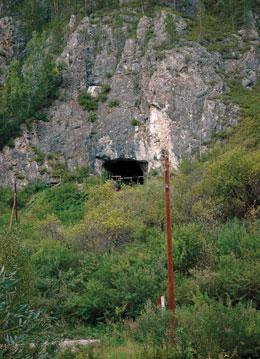Yesterday, 'high impact factor' journal Nature published an article concerning the discovery of Hominid remains. The most exciting finding is that the mitochondrial DNA of the fossils is distinct from modern humans and Neanderthals, even though this animal would have lived contemporaneously with both. That means this is either a new species, or at least a distinct genetic lineage from Africa which probably left no offspring (males of the group may have contributed some genetic information to modern humans- and this would be undetectable using mitochondrial DNA). It seems every time I turn around a new major discovery in our lineage is made! The Russian cave where the famous finger bone was found:
Article/Image Source:
http://www.nature.com/news/2010/100324/full/464472a.html
Friday, March 26, 2010
Sunday, March 21, 2010
Don't miss, LIFE
The newest epic nature documentary is finally here! And although I doubt it will be perfect...due to severe lack of David Attenborough, the footage promises to be mind blowing. Who knows, Oprah Winfrey may just have what it takes to give voice to nature. Don't miss it.
Friday, March 19, 2010
Large plants, revisited.
How big are these waterlilies?
Some are 6 feet across, so large that their leaves need air filled sacs to keep them afloat.
The Lily Trotter lives the majority of its life walking along them.
The flowers are a solid foot across.
Also they are beetle pollinated, which is somewhat rare and pretty cool. How does the flower change color though?
Some are 6 feet across, so large that their leaves need air filled sacs to keep them afloat.
The Lily Trotter lives the majority of its life walking along them.
The flowers are a solid foot across.
Also they are beetle pollinated, which is somewhat rare and pretty cool. How does the flower change color though?
Thursday, March 18, 2010
"This is the biggest flower in the world"
Amorphophallus titanum is one extreme flower. I have to laugh at the etymology of this name, 'amphorous' or without form, + 'phallos' or penis, and finally 'titan' meaning large or giant. This flower is named giant formless penis, and it smells "very strongly of dead fish". Also it's 9 feet tall and 3 feet across...and David Attenborough's crew were the first to figure out what insects pollinate this species:
Monday, March 15, 2010
Your friends the Demodex
Recently I came to the conclusion that mites are one of the most under-appreciated groups. Still, I was shocked to find out about Demodex folliculorum, a weirdly elongate mite that lives only in the hair follicles of humans. Demodex brevis, possibly a sister species, lives only in our sebaceous glands. Adults max out at a whopping .4mm, small enough to allow many to lay eggs on your eyelids (apparently a preferred location) without you even knowing they existed. What are the chances you are infected by Demodex? It depends on your age. Young children are estimated to be infected 1/3 of the time while approximately half of adults are infected. Other than some minor skin irritation the mites cause almost no harm to their host.
First image: a colored SEM of Demodex.
From:http://www.avls.nl/_main/images/stories/gezondheid/gezondheid%20demodex%20mijt.jpg
Second image: Demodex life cycle described from human eyelid.
Third image: Demodex elongated abdomen visible at the base of a hair.
Second and third images from:
English, F. et al. (2006) The natural history of demodectic mites on the skin of the eyelid margin. Journal of the European Academy of Dermatology and Venereology. 2(2) 132-136
First image: a colored SEM of Demodex.
From:http://www.avls.nl/_main/images/stories/gezondheid/gezondheid%20demodex%20mijt.jpg
Second image: Demodex life cycle described from human eyelid.
Third image: Demodex elongated abdomen visible at the base of a hair.
Second and third images from:
English, F. et al. (2006) The natural history of demodectic mites on the skin of the eyelid margin. Journal of the European Academy of Dermatology and Venereology. 2(2) 132-136
Sunday, March 7, 2010
Nature Photographers
Becoming a famous nature photographer is impossible, unless you submerge yourself in a watering hole and wait for lions to come take a drink. For three months. This man deserves a medal.
Image from:
http://www.dailymail.co.uk/news/worldnews/article-1253935/Photographer-captures-amazing-images-lions-watering-hole-submerging-months.html?ITO=1490
Image from:
http://www.dailymail.co.uk/news/worldnews/article-1253935/Photographer-captures-amazing-images-lions-watering-hole-submerging-months.html?ITO=1490
Wednesday, March 3, 2010
National Geographic is still keeping it real.
I might have to find a copy of this issue. Redwood forests were thought to be devoid of animal life, but recently all sorts of new species have been discovered living in composted soil trapped high in the trees. Including a crustacean (amphipod)...and you have to wonder how that got up there.
Subscribe to:
Posts (Atom)







